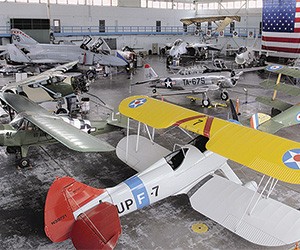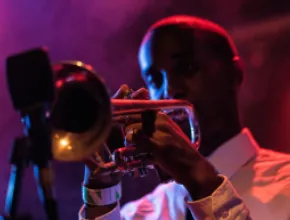Along the shores of the Great Lakes, northern Ohio hides a secret: the region has fascinating and far-reaching history, from the diverse ethnic heritage of Cleveland to the former oil boom town of Bowling Green. Eliot Ness, Amelia Earhart, Shirley Temple, Langston Hughes, Thomas Edison and U.S. President William McKinley are remembered here, along with sites dedicated to art and science. Whether it’s from a lighthouse along Lake Erie or the glasswork in the Toledo Museum of Art, Ohio shines.
Cleveland
Most people are familiar with a few of Cleveland’s biggest draws like the Rock & Roll Hall of Fame and Museum and the Cleveland Museum of Art, but planners may not know about the rich multicultural heritage of the area celebrated in sites and museums across the city.
Jewish history and achievements are celebrated at the Maltz Museum of Jewish Heritage, which promotes peace, tolerance and understanding. Exhibits reveal the touching stories of Jewish immigrants finding their own place in America and keeping their faith through the Great Depression and World War II. The museum welcomes group events with a 65-seat theater and black-box space for up to 250 dinner guests.
The Karamu House is the oldest African-American theater in the country, and has been the hub for local writers, actors, playwrights and dancers for nearly 100 years. Langston Hughes tested out many of his works here, and groups can still catch breathtaking original plays and thoughtful adaptations of modern classics.
Visitors can also experience the city’s ethnic heritage and diversity with their taste buds, according to Jackie Spencer, public relations and communications coordinator with Destination Cleveland.
“Just east of downtown Cleveland, Asia Town is home to two-dozen family-owned eateries serving up authentic and affordable cuisine from Chinese, Vietnamese and Korean cultures,” she says, “and the iconic neoclassical West Side Market is the oldest publicly-owned market in the city. More than 180 vendors sell fresh fruits, vegetables and foods ranging from pierogi to falafel.”
Cleveland also has plenty of pop culture history to celebrate, from famed agent Eliot Ness and other law enforcement professionals at the Cleveland Police Museum to the accomplishments of women like Amelia Earhart, Harriet Quimby, Bessie Coleman and more at the International Women’s Air & Space Museum. Groups can even catch a bit of nostalgia at the A Christmas Story House & Museum, as seen in the film of the same name.
Akron
History is alive and well in Akron, located on the southern outskirts of Cleveland. One of the largest historical attractions is Hale Farm & Village, a living history site reconstructed to represent Ohio life in the 1850s.
“From pottery to glass blowing to blacksmithing and broom-making, visitors are immersed into the daily lives of our area’s early settlers,” says Jim Mahon, vice president of marketing and brand management for the Akron/Summit CVB. “A whole host of special events dot every season, including maple sugaring, lantern tours and an annual Made in Ohio Festival.”
Planners can choose to hold an event in the village itself, such as the Carriage Pavilion or Apple Orchard, or choose a space in the History Center, such as the breathtaking Crawford Rotunda or Carousel Glass Pavilion.
Once home to the co-founder of Goodyear Tire and Rubber Company, the Stan Hywet Hall & Gardens is another larger-than-life historical experience. Officially the sixth largest private home open to the public in the U.S., the Stan Hywet is a stunning example of luxury living in the Jazz Age. The Manor House, where both Will Rogers and Shirley Temple stayed, features 23 fireplaces, hand-carved paneling and more than 21,000 panes of glass. More than 90 percent of the furnishings are original to the home.
In addition to a variety of event and meeting spaces, groups can watch a Vintage Base Ball game, which differs greatly from today’s version of the sport; enjoy a Living History interactive tour with a talented troupe interpreting life from the 1920s; or participate in geocaching events or scavenger hunts.
Akron also boasts a number of intriguing museums as well, including the American Toy Marble Museum, located in the former factory of the American Marble & Toy Company and the Center for the History of Psychology, a fascinating look into the history of human sciences.
Canton
When it comes to history, Canton heads straight to the top. The area is home to the William McKinley Presidential Library & Museum, dedicated to the legacy of the 25th U.S. President. The campus offers plenty of historic activities, from tours to tea service, or science-related activities in the planetarium and Discover World, an on-site interactive natural science center. As a counterpoint, the area is also home to the National First Ladies’ Library, which serves as the premier research center and museum for the contributions and life stories of America’s First Ladies. The facility offers meeting space and a 91-seat theater. Planners can round out the day with a visit to the Dragonfly Tea Room, located in the historic 1901 Blank House in nearby Canal Fulton.
PageBreak
Sports history is also an important part of northern Ohio, and the Pro Football Hall of Fame is a favorite stop for group events. Planners can choose from the Event Center, Lounge or an outdoor event on the Plaza, and Hall of Famers can also mingle with the group. For a different kind of raw power, groups can also hold events at the MAPS Air Museum in north Canton, and dine in the hangar underneath vintage aircraft.
Lake Erie Shores and Islands
Along the Ohio side of the Great Lakes are numerous towns and islands, all packed with history. In Sandusky, groups can tour the Cedar Point Lighthouse; walk through the historic Cooke-Dorn House, a fine example of the town’s limestone structures; or hold a reception at the Merry-Go-Round Museum.
In Milan, groups can tour the birthplace of Thomas Edison and see his work re-created. In Marblehead, visitors can tour the oldest continually operating lighthouse on the Great Lakes at Marblehead Lighthouse State Park. Throughout the whole area, groups can enjoy boat tours, from sailing to airboats and day cruises.
Toledo
There’s more to Toledo than meets the eye; the city has an impressive collection of museums and historic sites, starting with the National Museum of the Great Lakes.
“The National Museum of the Great Lakes reveals the haunting and fascinating history of our treasured Great Lakes that make up 84 percent of the fresh surface water in North America,” says Cathy Miller, director of tourism for Destination Toledo.
The museum features 250 artifacts and dozens of hands-on exhibits, including a life raft from the wreck of the SS Edmund Fitzgerald.
Perhaps most famous is Toledo’s commitment to art: the Toledo Museum of Art is known internationally for its collections, including the glass pavilion, dedicated to glassblowing and artworks. Another amazing art site is the Blair Museum of Lithophanes. These porcelain castings show three-dimensional images when lit, and the largest collection of these unique artworks is located at the museum within the Toledo Botanical Garden.
Groups can also tour the Sylvania Historical Village, located in nearby Sylvania’s historic downtown. The village showcases late 19th century life, from an 1840 log home and pioneer items to a train depot and barn that contains a 1915 locomotive.
At Fort Meigs, groups can explore a reconstructed fort and museum commemorating Ohio’s role in the War of 1812. Both police and firefighters get their due with museums; the Toledo Firefighters Museum has vintage equipment and uniforms spanning 150 years, while the Toledo Police Museum offers something extra with the exhibits: a chance to have attendees’ mug shots taken with a booking camera from the 1920s.
Bowling Green
The history of Bowling Green is all about getting things done, from the National Construction Equipment Museum to a historical walking tour of downtown when Bowling Green was an oil boom town in the 1800s. Along the walking tour, according to Wendy Chambers, executive director for Bowling Green CVB, visitors will see the Wood County Courthouse, which features one of the largest working hand clocks in the country, and many lovely residential homes located in the historic Boom District. Groups can also enjoy the Wood County Historical Center & Museum, or get nostalgic for some classic rides at Snook’s Dream Cars Automobile Museum. All welcome groups, according to Chambers.
“Yes, there’s group pricing for guided and self-guided tours of the museums, and the downtown offerings are free,” she says.
Another bit of nostalgia awaits at the Little Red Schoolhouse, a living history education museum on the campus of Bowling Green State University. Built in 1875 and moved to the campus, the schoolhouse provides a look into another time with exhibits and interpreters available.






